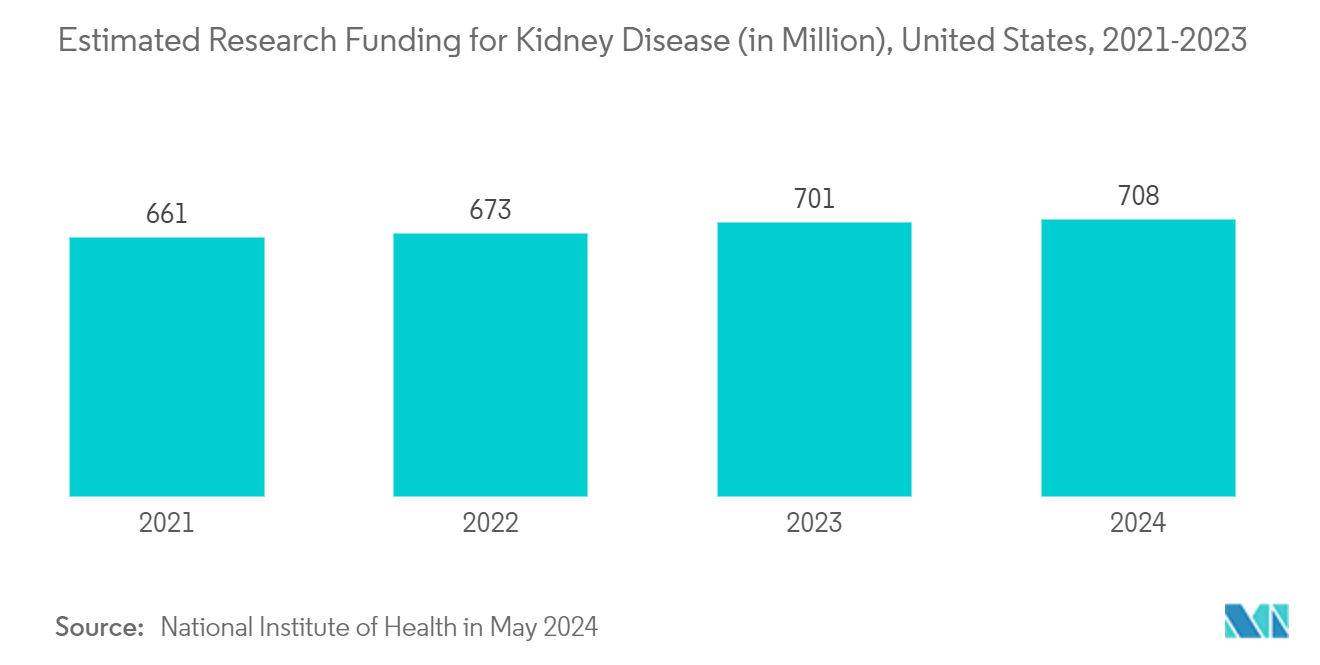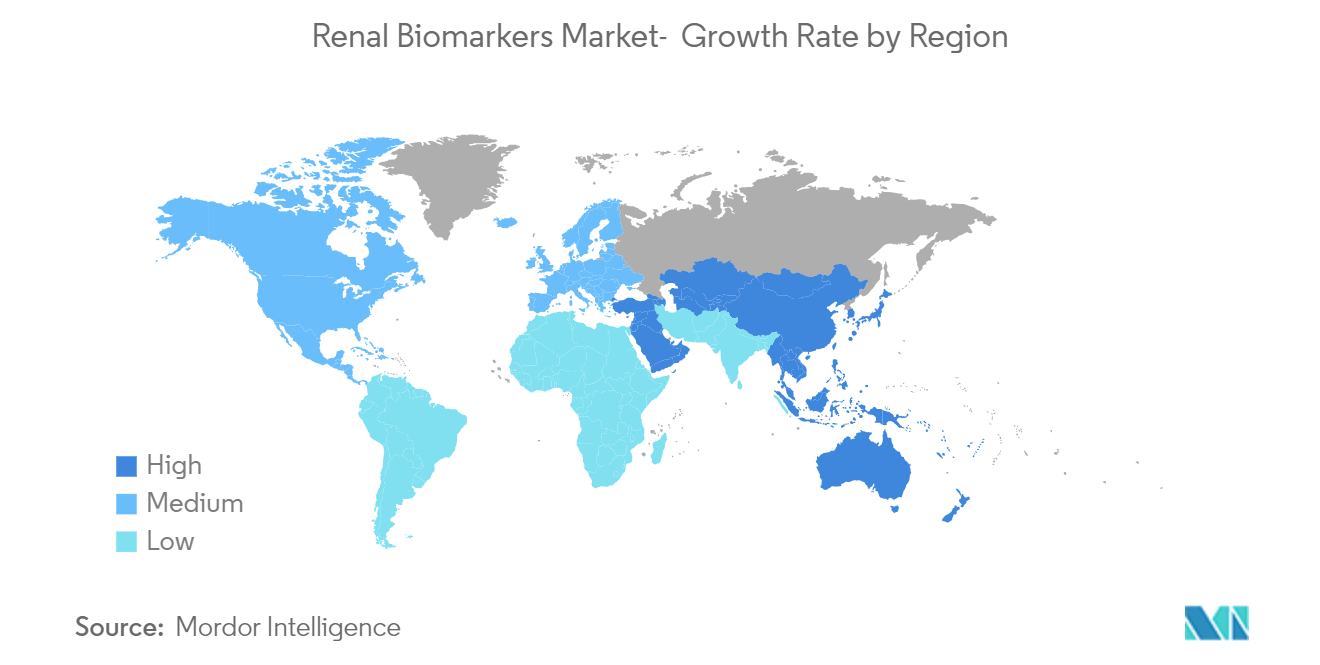Market Trends of Renal Biomarkers Industry
Neutrophil Gelatinase-Associated Lipocalin (NGAL) is Expected to Project Significant Growth Over the Forecast Period
NGAL (Neutrophil Gelatinase Associated Lipocalin) is a novel biomarker that is being used to diagnose acute renal injury (AKI) early. Elevation of NGAL levels has been documented in the plasma and urine of animal models of ischemic and nephrotoxic AKI. Therefore, NGAL is also considered a novel urinary biomarker for ischemic injury. The loop of the Henle, the thick ascending limb, and the intercalated cells of the collecting duct are the primary areas of NGAL production in the kidney.
NGAL is also helpful in reducing an injury by stopping apoptosis and increasing the normal proliferation of kidney tubule cells. More specifically, NGAL has been reported to up-regulate heme-oxygenase-1, which preserves proximal tubule N-cadherin and inhibits cell death.
The rising research for NGAL testing and the approvals from the regulatory agencies for the NGAL tests are anticipated to increase the adoption of NGAL tests, thereby boosting the segment growth. For instance, in December 2023, Bioporto received United States Food and Drug Administration 510(k) approval for the NGAL biomarker for acute kidney injury (AKI) biomarker test for pediatric use in the United States.
Furthermore, the rising strategic partnerships for the development of NGAL biomarkers are anticipated to increase the adoption of this test to diagnose AKI, thereby boosting the segment growth. For instance, in February 2024, BioPorto A/S entered a collaboration with Roche Diagnostics to commercialize BioPorto's NGAL test as ProNephro AKI (NGAL) on Roche's cobas c 501 platform. Such commercialization agreements help increase NGAL testing adoption, driving the segment growth.
Additionally, the rising importance of NGAL testing in patients with contrast-induced acute kidney injury (CI-AKI) is anticipated to boost the segment growth further. According to the study published in the Diagnostics Journal in March 2023, the diagnostic efficacy of NGAL is outstanding. NGAL may act as a reliable biomarker for the early diagnosis of clinical and subclinical forms of renal injury after contrast angiography. Therefore, the high clinical diagnosis performance of NGAL biomarkers in assessing renal disease is anticipated to boost the demand for the segment studied, surging the market expansion.
Hence, with growing research and development activities, strategic partnerships for the development of NGAL, and the significance and efficacy of NGAL in detecting kidney conditions, the segment is expected to have steady growth over the forecast period.

North America is Expected to Hold a Significant Share in the Market and Expected to do Same Over the Forecast Period
North America currently holds a significant share of the market for renal biomarkers, and it is expected to continue its stronghold over the forecast period. The United States holds the largest market share in the North American region. In the past decade, there has been a significant increase in the number of FDA approvals containing information on molecular biomarkers. Almost every pharmaceutical company has been developing molecular biomarker programs through partnerships or other ventures.
The rising prevalence of chronic kidney disorders among people in the United States is a major factor attributed to the increasing usage of renal biomarkers for effective diagnosis and to boost the market growth in this region. For instance, according to the data published by the Centers for Disease Control and Prevention (CDC) in May 2023, 14.0% of adults in the United States, i.e., about 35.5 million, are estimated to have chronic kidney disease.
Additionally, the increasingly vulnerable aging population that is prone to chronic kidney diseases in the United States is also contributing to the rising demand for early-stage diagnosis and effective treatment, thereby contributing to the growth of the market. For instance, according to the data published by the Centers for Disease Control and Prevention (CDC) in May 2023, chronic kidney disease is accounted to be the most common in people aged 65 years or older, contributing to 34.0% of the affected population in the United States. Such a high prevalence of chronic kidney disease is projected to drive the adoption of effective diagnostic options, thereby influencing market growth.
Furthermore, the increasing focus of government agencies in the United States on developing and improving diagnostic tests for kidney diseases eventually increases the demand for renal biomarkers. For instance, in December 2023, the National Institute of Standards and Technology (NIST) developed the first human urine standard with precise measurements of albumin, a biomarker used to check the functionality of the kidneys. The standard will support decisions for diagnosing kidney diseases and improve health outcomes for people. Such government initiatives for improving the accuracy of diagnosing and managing kidney diseases are projected to drive the growth of renal biomarkers in the country.
Moreover, strategic activities adopted by the market players, such as Food and Drug Administration (FDA) approvals, product launches, and clinical trials, are expected to boost the market growth over the forecast period. For instance, in February 2023, Aravive Inc. demonstrated positive results from the Phase 1b/2 trial of batiraxcept in clear cell renal cell cancer (ccRCC) and a biomarker-high subgroup at the 2023 ASCO Genitourinary (GU) Cancers Symposium in the United States. Therefore, such clinical trials will boost the development of biomarker tests in the country. This will subsequently drive market growth.
Major companies are strategically entering into partnerships and collaborations with mid-sized companies in renal biomarkers to broaden the products and services offered by the company. For instance, in January 2024, LifeLabs, a Canada-based healthcare management and laboratory services provider, partnered with Klinrisk, a Canadian AI-based medical device company focused on improving the early detection and treatment of chronic kidney disease (CKD) through the groundbreaking Klinrisk Score. Klinrisk test analyzes routine blood and urine samples. It delivers a comprehensive report indicating the risk of progression for kidney function loss of up to 40% or kidney failure in the next five years. LifeLabs and Klinrisk join forces to revolutionize chronic kidney disease care. Such strategic initiatives are projected to drive market growth. These strategic activities would further increase the availability of renal biomarkers in the region, contributing to the market’s growth.
Thus, owing to the rising prevalence of chronic kidney disease, the increasing focus of government agencies on developing diagnostic tests, and strategic activities such as FDA approvals, clinical trials, and new product launches and partnerships by the market players in North America, the market is expected to witness a significant growth rate over the forecast period.


